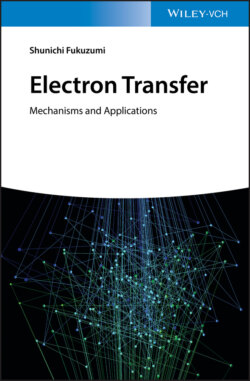Читать книгу Electron Transfer - Shunichi Fukuzumi - Страница 11
3 Photosynthetic Reaction Center Models
ОглавлениеThe first candidates of artificial photosynthetic reaction centers are porphyrins, which have been involved in a number of important biological electron‐transfer systems including the primary photochemical reactions of chlorophylls in the photosynthetic reaction centers. Porphyrins contain an extensively conjugated two‐dimensional π‐system and are thereby suitable for efficient electron transfer, because the uptake or release of electrons results in minimal structural and solvation change upon electron transfer, resulting in a small λ value of electron transfer [30]. In addition, rich and extensive absorption features of porphyrinoid systems guarantee increased absorption cross sections and efficient use of the solar spectrum [30]. In contrast with the two‐dimensional porphyrin π‐system, fullerenes contain an extensively conjugated three‐dimensional π‐system [31]. Electron transfer to C60 is highly efficient because of the minimal changes of structure and solvation associated with the electron‐transfer reduction [31–33]. Thus, a series of porphyrin–fullerene linked molecules have been designed and synthesized to mimic the charge‐separation processes in the photosynthetic reaction center, starting from a zinc porphyrin–C60 dyad (ZnP–C60), a ferrocene–zinc porphpyrin–C60 triad (Fc–ZnP–C60), a zinc porphyrin‐free base porphyrin–C60 triad, up to a tetrad (Fc–ZnP–H2P–C60) [34–39].
The driving force dependence of the electron‐transfer rate constants (kET) of these dyad, triad, and tetrad molecules for CS and CR processes is shown in Figure 3.1, where log kET is plotted against the driving force (−ΔGET) [39]. The lines in Figure 3.1 represent the best fit to Eq. (2.1) (ZnP–C60: λ = 0.66 eV, V = 3.9 cm−1; Fc–ZnP–C60, Fc–H2P–C60, and ZnP–H2P–C60: λ = 1.09 eV, V = 0.019 cm−1; Fc–ZnP–H2P–C60: λ = 1.32 eV, V = 0.00017 cm−1) [39]. The λ‐value increases, whereas the V value decreases with increasing edge‐to‐edge distance in the order of the dyad (Ree = 11.9 Å), the triad (Ree = 30.3 Å), and the tetrad (Ree = 48.9 Å). Such an increase in the λ value with increasing distance results from an increase in the solvent reorganization energy (λs), because the λs value is known to increase with increasing distance between an electron donor and an acceptor as given by Eq. (3.1):
(3.1)
where r1 and r2 are the radii of the donor and acceptor, r12 is the donor–acceptor distance, ε is the dielectric constant, and n is the refractive index [6,40].
Figure 3.1 Driving force (−ΔGET) dependence of intramolecular electron‐transfer rate constants (kET) in ZnP–C60 (CS [○]; CR [□]), Fc–ZnP–C60 (•), Fc–H2P–C60 (▴), ZnP–H2P–C60 (▪), and Fc–ZnP–H2P–C60 (△).
Source: Imahori et al. 2001 [39]. Reproduced with permission of American Chemical Society.
Figure 3.2 Edge‐to‐edge distance (Ree) dependence of optimal electron‐transfer rate constants (log[kET(optimal)/s−1]) in ZnP–C60 dyad, Fc–ZnP–C60 triad, Fc–H2P–C60 triad, ZnP–H2P–C60 triad, and Fc–ZnP–H2P–C60 tetrad. The line represents the best fit to Eq. (2.1) (β = 0.60 Å−1, V0 = 210 cm−1).
In the case of the dyad, the CR rate in ZnP·+–C60·− in the Marcus inverted region is much slower than the CS rate constants from both the singlet and triplet excited states in the Marcus normal region (Figure 3.1). This enables subsequent electron transfer from Fc to ZnP·+ in the triad (Fc–ZnP·+–C60·−) and from ZnP to H2P·+ in ZnP–H2P·+–C60·− to produce the final CS state, Fc+–ZnP–C60·− and ZnP·+–H2P–C60·−, in competition with the back electron transfer in the initial CS states. In the case of Fc+–ZnP–H2P–C60·−, the charges are separated at a long distance (Ree = 48.9 Å) [39]. The lifetime of the resulting CS state at such a long distance in a frozen benzonitrile (PhCN) has been determined as 0.38 seconds [39]. Similar tetrad and pentad compounds were reported to attain long‐lived CS states up to 1.7 seconds [40–42]. It should be noted that the CS lifetime is temperature independent, since the CR process is at the Marcus top region (Figure 3.1) [39]. This is the first example to achieve a CS lifetime that is comparable to that observed for the bacterial photosynthetic reaction center. However, such an extremely long CS lifetime could only be determined in frozen media, since in condensed media bimolecular back electron transfer between two Fc+–ZnP–H2P–C60·− is much faster than the unimolecular CR process [39]. The maximum kET values (kETmax) of dyads, triads, and tetrads in the Marcus plot (Figure 3.2) are correlated with the edge‐to‐edge distance (Ree), separating the radical ions, according to Eq. (3.2) [39]:
(3.2)
where V0 refers to the maximal electronic coupling element, while β is the decay coefficient factor (damping factor), which depends primarily on the nature of the bridging molecule. From the linear plot of ln kETmax vs. Ree the β value is obtained as 0.60 Å−1 [39]. This β value is located within the boundaries of nonadiabatic electron transfer reactions for saturated hydrocarbon bridges (0.8–1.0 Å−1) and unsaturated phenylene bridges (0.4 Å−1) [43].
Scheme 3.1 Multistep photoinduced electron transfer in a ferrocene‐meso, meso‐linked porphyrin trimer–fullerene pentad (Fc–(ZnP)3–C60); Ar = 3,5‐But2C6H3.
Source: Imahori et al. 2004 [44]. Reproduced with permission of John Wiley & Sons.
The best molecule mimicking multistep electron‐transfer processes in the photosynthetic reaction center so far reported is a ferrocene‐meso, meso‐linked porphyrin trimer–fullerene pentad (Fc–(ZnP)3–C60 in Scheme 3.1), where the C60 and the ferrocene (Fc) are tethered at both the ends of (ZnP)3 (Ree = 46.9 Å) [44]. The lifetime of the final CS state (0.53 seconds at 163 K) has been attained without lowering the CS efficiency (Φ = 0.83) [44].
